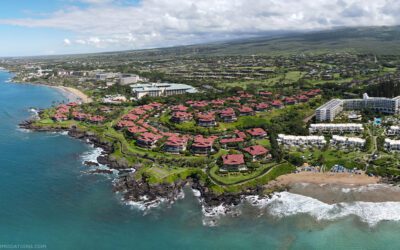If you love the feel of soft, sun-warmed sand between your toes, then Maui — with 30 miles of beaches— is the place for you!
Maui’s beaches offer something for everyone, catering to both kick-back-underneath-a-palm-tree types and active adventurers. Some Maui beaches are world-famous for water sports; some boast fantastic snorkeling; others are well-suited for sunbathing or families with young children.

No two beaches on the Valley Isle are alike: Maui beaches range from small coves to vast stretches, with sand that is colored white, gold, brown, black, or more exotic shades like red or green.
Some beach areas have been developed into lovely beach parks with public facilities for beachgoers and picnickers; others are remote, rugged, and pristine.
Below, you’ll find a quick round-up of our favorite Maui beaches, broken down into different categories, such as the best Maui beaches for snorkeling, surfing, sunsets, and so on.

Kamaole Beach III
Best Beaches for Sunsets on Maui
The best beaches to catch a Maui sunset? You’re going to want to stick to the south (Kihei/Wailea) and west (Kaanapali/Napili) sides of the island.
- Kamaole I, II, or III, Kihei — Each one of these beach parks offer unparalleled sunset views. Hang out on the sand, the seawall, or grassy lawn and soak up the last rays.
- Po’olenalena Beach, Makena — Secluded Wailea-Makena sunset beach with beautiful views. A very popular wedding beach at sunset! No facilities.
- Napili Bay, Napili — One of the best sunset spots on the west side. Hang on the sand, or at the bar at the iconic Seahouse Restaurant.
- Kaanapali Beach, Kaanapali — This three-mile sandy strip is one of the best beaches for sunset on Maui.

Maluaka Beach
Best Beaches For Snorkeling on Maui
Not all beaches are snorkeling beaches on Maui. Stick to reputable snorkeling spots, and always snorkel with a buddy!
- Ulua Beach, Wailea — Sandy entry with easily accessible reef, great for beginners in good conditions!
- Keawakapu Beach, Kihei — Stick to the point in front of the Mana Kai Resort for awesome coral formations, fish, and turtles.
- Olowalu Beach, Olowalu — Maui’s “Mother Reef,” home to a 1,000 acre reef with 800 year old coral heads. A long swim, so go with a tour or at your own risk.
- Kapalua Bay, Kapalua — Protected, user-friendly snorkeling near the north-east corner of the bay.
- Maluaka Beach, Makena — Great snorkeling on the left hand (southern) side of the beach. Clear water and coral formations galore!

The Cove – Kalama Park
Best Beaches for Surfing on Maui
Whether you’re a beginner or expert, here are some of Maui’s most popular surfing beaches.
- Kalama Park (The Cove), Kihei — Excellent beginner spot in the heart of Kihei. Book a lesson or rent a board. Beware shallow reef!
- Ukumehame, Olowalu — Long sandy beach with many peaks, known for long rolling rides. Best in the summer months.
- Hookipa, Paia — Experts only! Popular break on Maui’s north shore, known for consistent surf! In wintertime, waves here can exceed 20 feet.
- Launiupoko, Lahaina — Mellow reef break with multiple peaks. Best in the summer months. Beware the shallow reef!

Kapalua Bay
Best Beaches for Sunbathing
While any patch of sand could qualify as a Maui beach for sunbathing, here are some of the beaches we prefer.
- Keawakapu Beach, Kihei — Longy sandy beach with plenty of sun!
- Kamaole I, II, III, Kihei — You can’t go wrong with parking your towel on any one of these three sandy beaches.
- Kahekili Beach (Airport Beach), Kaanapali — Nearly a mile of sand to lay out on plus showers and restaurants. Bonus: the snorkeling is also great here.
- Kapalua Bay, Kapalua — This sandy cove is mostly protected from the midday tradewind-fueled sandstorms.
- Makena State Park (Big Beach), Makena — The strong shorebreak makes this beach dangerous for swimming, but there’s almost a mile of sunny sand to enjoy.

Best Beaches For Kids on Maui
Some Maui beaches have strong currents or dangerous waves. Here are some of the safest beaches for little ones.
- Baby Beach, Paia — Sandy beach with protective outer reef. (pictured above)
- Kalepolepo Beach Park, Kihei — Sandy beach with protected fish pond.
- Sugar Beach, Kihei — Long sandy beach with protected tide pools.
- Ulua Beach, Wailea — Sandy beach with minimal shore break (subject to change based on conditions.)
- Kapalua Bay, Kapalua — Sandy beach with minimal shore break (subject to change based on conditions.)
MAUI BEACH TIPS —WHAT YOU NEED TO KNOW
First, The Legal Stuff: The Rules
- There are no private beaches on Maui. It’s true! All beaches on Maui are public. State law asserts that any land below the highest wash of the waves is state property, and therefore open to the public. However, the land mauka of that point could be privately owned. So although all beaches are technically public, you still can’t cross private property to access a beach. Fortunately, most beaches that front private property have public access easements. Make sure you look for public beach access signs and park in designated public parking areas. Here’s more information on where to find shoreline access for Maui’s beaches.
- Access to most Maui beaches is FREE. There are a few exceptions at some State beach parks and natural reserves where parking and/or entry fees are now charged. In addition to managing overcrowding, the fees are used to preserve and maintain these fragile shoreline environments. In south Maui, fees are now charged at Makena State Park and at the Ahihi-Kinau Natural Area Reserve in Kanahena (on the way to La Perouse Bay). In East Maui (Hana area), advance reservations and parking/entry fees are now required for Waianapanapa State Park (famed for its black sand beach).

- Maui’s beaches and beach parks are smoke-free. Cigarettes are the single largest source of ocean pollution, with 4.5 trillion butts ending up in the sea annually. In 2014, a bill was passed prohibiting smoking in all Maui county beach parks, punishable by a fine of up to $500.
- In general, alcoholic beverages are not allowed on Maui’s beaches. There are many State and County laws restricting the consumption of alcohol on or near Maui beaches or beach parks. Unfortunately, these laws are so varied and convoluted, it is virtually impossible to know when it is or is not legal to drink an alcoholic beverage on the beach. Laws vary depending on which beach it is and your proximity to a school, public restroom, public lookout, public highway, public sidewalk, municipal parking lot, etc. etc. etc. (Really. I am not kidding.) So, it’s just safer NOT to drink alcohol at the beach (alcohol and the ocean are a deadly combination, anyway). You might see people doing it, and the laws are not strictly enforced, but just be forewarned that when you pop open that icy cold beer or enjoy a sunset sip of chardonnay on the beach you are likely breaking the law.
- Reef safe sunscreen only, please! Did you know sunscreen that isn’t mineral-based is actually banned on Maui? The use, sale, and distribution of non reef safe sunscreen was outlawed on Maui in October 2022. Instead of bringing sunscreen from the mainland, consider buying it on Maui. This way you ensure that you’re only using reef safe sunscreen. If you’re unsure if your sunscreen is reef safe, check the ingredients. The only active ingredients should be zinc oxide or titanium dioxide.
Next, The Cautionary Stuff: Ocean Safety
Sadly, drowning is the leading cause of visitor deaths in Hawaii, and debilitating injuries and ocean rescues happen weekly— sometimes daily— across the state.
The ocean in Hawaii is powerful and conditions can change in the blink of an eye. Always heed posted warning signs, listen to lifeguards and local beachgoers, and use your best judgement when entering the ocean. As the saying goes, “if in doubt, don’t go out“.
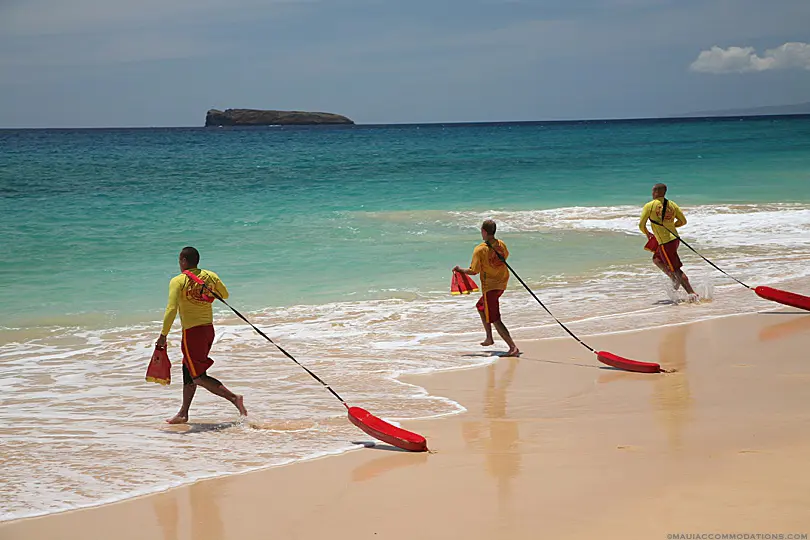
Sometimes the ocean here looks like a lake, with tiny waves gently lapping the shore. Other times, massive waves come crashing in with frightening intensity.
North Shore and East Maui beaches are more exposed to changing weather, strong ocean currents, and dangerous shorebreaks, so be extra careful there.
West Maui and South Maui tend to have calmer ocean and beach conditions, although dangerous conditions can occur there, as well.
The surf at South Maui’s Makena Beach (aka Big Beach; pictured above in the large heading photo) is infamous for knocking people down and causing injuries, and the West Maui bays from Kapalua to the north, like Mokuleia and Honolua, can be very dangerous, particularly with high winter surf.
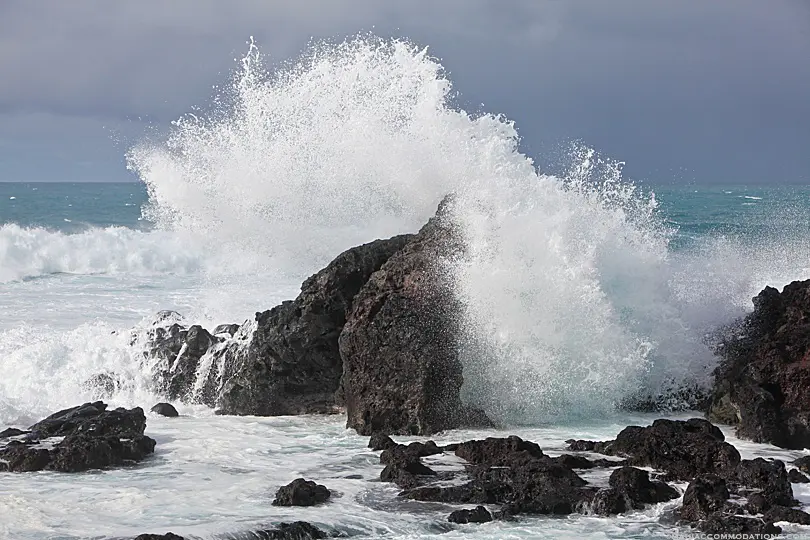
For added safety, head for one of these ten beaches that have County lifeguards (staffed daily from 8 a.m. to 4:45 p.m.):
- South Maui: Kamaole Beach Parks I, II and III in Kihei; Makena State Park, aka “Big Beach”
- West Maui: Hanakaoo Beach in Kaanapali (aka “Canoe Beach”); D. T. Fleming Beach in Kapalua
- North Shore: Kanaha Beach in Kahului; H.A. Baldwin Park in Paia; Hookipa
- East Maui: Hana Bay (limited seasonal schedule)
You can find real-time updates regarding current ocean conditions at the above beaches here. And check out these live webcams to see actual weather conditions around the island.
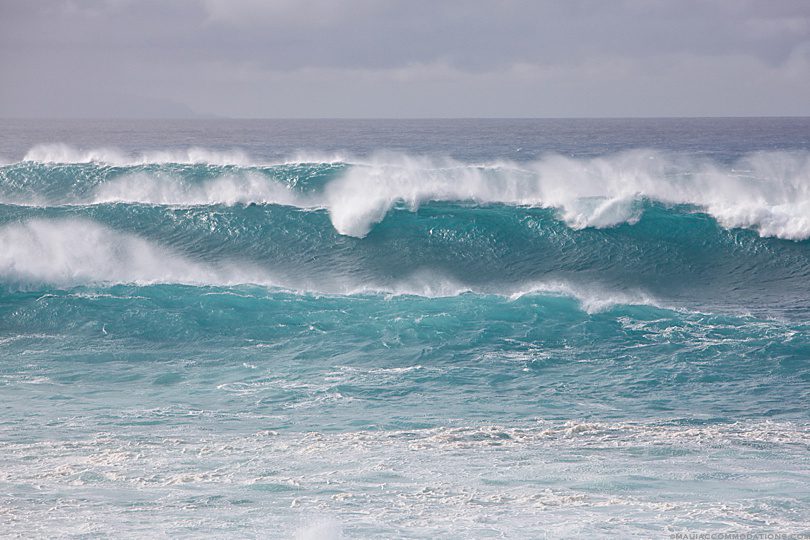
Some additional ocean safety tips:
- “Never turn your back to the sea” is a common warning here. Don’t be caught off-guard. An unexpected wave can knock you down and pull you out to sea (or seriously injure you) while you’re still trying to get your flippers on! So keep your eyes on the surf.
- Avoid walking or stepping on the reef. Not only is coral extremely sharp and riddled with infection-causing bacteria, but it is a living organism— and a vital one, at that. Stepping on coral kills it, so avoid walking or putting your feet down anywhere but sand patches while snorkeling.

- Pay attention to the signs and flag warnings that are posted on some of the more populated beaches. They are there to advise you of unsafe conditions.
- Use the buddy system. Never swim, snorkel, or surf alone in the ocean. Make sure someone knows you are there and is looking out for you.
- Stay out of the ocean after flash floods. Floods send all the yucky stuff that collects on land— dead animals, sewage, and untold amounts of bacteria— careening down into the sea. It’s best to avoid swimming until the water clears up again. Plus, murky waters attract predators, and you don’t want to be mistaken for a fish or turtle when they’re looking for a snack.
You’ll find an Ocean Safety Guide, “Swim Safe” Shark Tips, and an excellent ocean safety video here.
Okay. I hope I haven’t scared you off with all this talk of rules and drownings and (eek!) predators. Of course, thousands of people safely enjoy Maui’s beaches every day, so it’s most likely that you will have an incredible and uneventful beach experience. But a little caution goes a long way, and being informed and aware is NEVER a bad thing when it comes to ocean safety!
Finally, The Fun Stuff! Your Day At The Beach
- What to take TO the beach: drinking water, reef-safe sunscreen (at least SPF30–see more below), towels or beach mats (beach chairs, if you wish), bag for your trash, sunglasses, sun hat, beach shoes or slippers, and a change of clothes if you plan to go somewhere afterwards (wet swimsuits are not very comfortable for strolling around town!)
- What to leave AT the beach: footprints. That’s it. Our island environment, both on land and in the sea, is precious and fragile. Please respect it. Dispose of your trash properly. Don’t leave cigarette butts — or anything else — in the beach sand (and besides, now you know that smoking is prohibited on Maui beaches).
- What to take FROM the beach (other than your trash): unforgettable memories. Be cautious about removing any natural items to take as souvenirs, and don’t plan to take a scoop of Maui beach sand home with you as a memento. As of 2013, it is illegal to take sand from Hawaii beaches. It is also illegal to take dead coral, rocks and most other “marine deposits” from the beach. The exceptions are driftwood, shells, beach glass, glass floats, and seaweed.

- The Snorkel Store on Maui issues a daily snorkel report with the latest conditions around the island for the best snorkeling. Sign up and get this report so you can check out the best snorkel spots each day!
- Maui’s tropical sun can burn you fast, even more so when you are near the water, and even on a cloudy overcast day. Nothing can ruin a vacation faster than a painful sunburn! Keep slathering on your high-SPF sunscreen throughout the day (remember, reef safe only, please!). Better yet, cover up! Rash guards, hats, and umbrellas are your best friend during a Maui beach day.

- Please enjoy but don’t feed the fish or any other wildlife. And remember, don’t approach or disturb a Hawaiian monk seal, green sea turtle, or any other endangered or protected wildlife. Admire them from a distance.
- Beach Sunsets: weather permitting, you can see spectacular sunsets from both South and West Maui beaches. And if it’s clear on the horizon at sunset, keep your eyes open for the rare green flash. In South Maui, you can catch beautiful sunsets from Makena to Kihei. In West Maui, great sunset viewing extends all the way north to Kapalua Beach. But once you turn the bend to DT Fleming Beach (at the Ritz Carlton Resort), you lose the direct sunset view. So plan your sunset-watching accordingly!
Wishing you many safe, memorable beach days on Maui!
- Looking for great places to stay on Maui? You’ll save by BOOKING DIRECTLY with the owners/managers of these accommodations.
- Looking for Maui deals? Sign up here for our free monthly Maui Deals & Steals enewsletter with the latest book-direct deals from our advertisers.

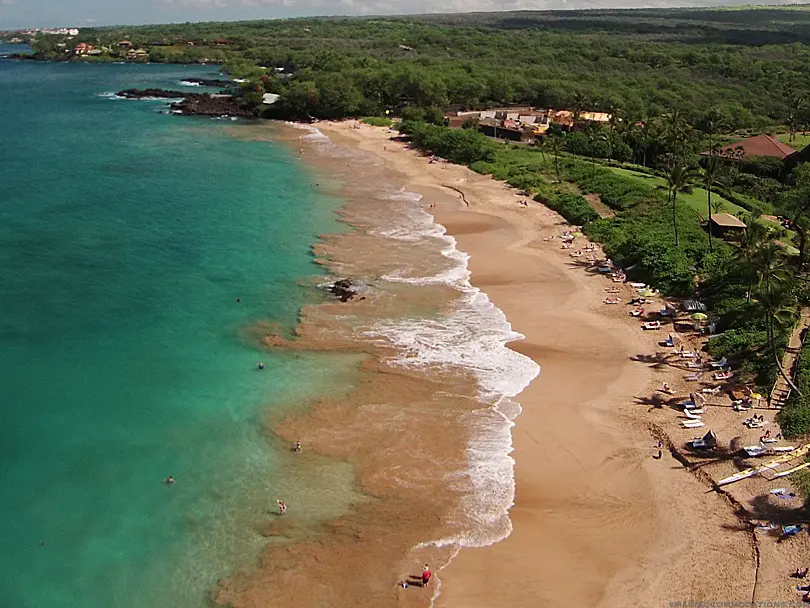
 Aloha! Tiffany here. I've been blessed to call Maui home since 2011. With a background in the island's finest restaurants and hotels, guiding visitors to create unforgettable Maui memories is more than a skill I've mastered—it's a profound source of joy for me.
Aloha! Tiffany here. I've been blessed to call Maui home since 2011. With a background in the island's finest restaurants and hotels, guiding visitors to create unforgettable Maui memories is more than a skill I've mastered—it's a profound source of joy for me.



